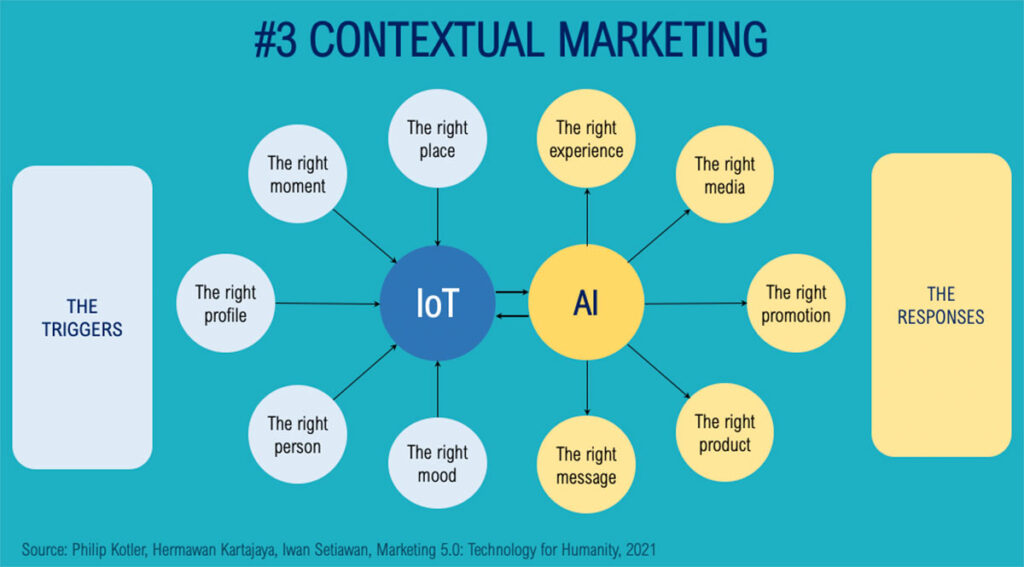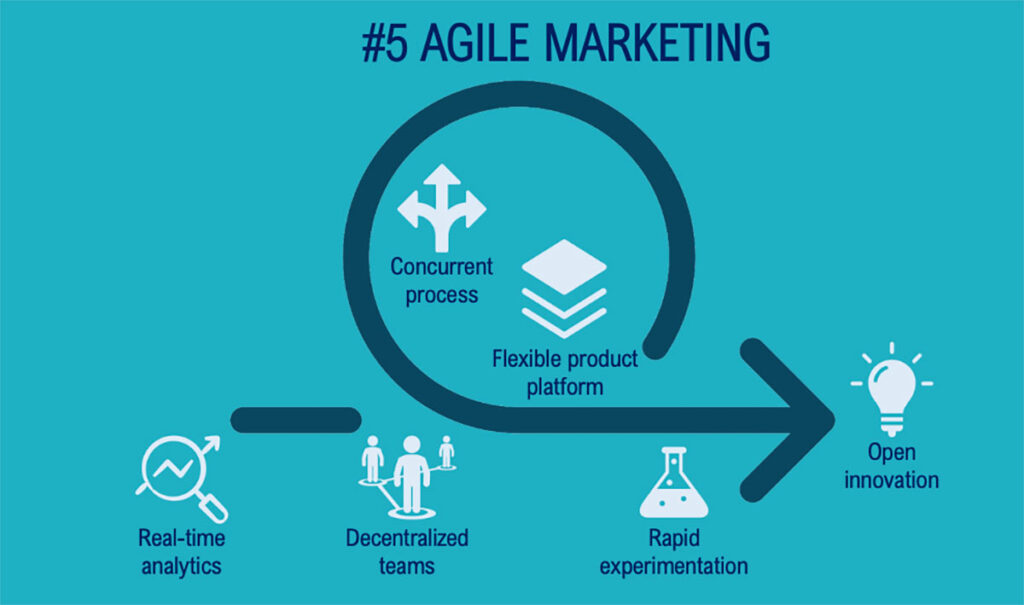“Kotler’s Marketing 5.0” (Japanese edition) has been released in April 2022.
transcosmos held a webinar by Mr. Ivan Setiawan, the co-author of this book, in December 2020, which was very well received. The contents of what the co-author himself had to say about the contents of “Marketing 5.0” are summarized in this article.
This article presents the final “the five Components of Marketing 5.0“.
Contents
The five components of Marketing 5.0

Marketing 5.0 consists of five elements. The two elements shown in blue are referred to as the “two disciplines” and the three elements shown in white are referred to as the “three applications.
・Data Driven Marketing
・Predictive Marketing
・Contextual Marketing
・Augmented Marketing
・Agile Marketing
Let’s take a brief look at each of these. Knowing these elements is important for understanding and implementing “Marketing 5.0,” and understanding how to proceed and what it entails will be more useful for amplifying the customer experience in the future.
Data Driven marketing

The first one is data-driven marketing. It is about how we use data to make decisions and how we gather data to help us make decisions.
Data-driven marketing begins with defining goals. What do you want to accomplish, what issues do you want to solve, and what analysis will you perform to achieve these goals and find the data to accomplish them and find the answers.
The expansion of Big Data allows us to take many sources of data. There are six major categories, and data from all of these data categories is used to solve business problems and achieve business goals. For example, there is what is called ①social data, which is taken from social networking conversations. There is also ②media data from traditional media such as television, newspapers and magazines. There is also ③web data taken from Internet interactions and browsing history, and ④POS data. This relates to transactions that take place in retail stores. ⑤IoT data is data taken from the use of smartphones and sensors in retail. ⑥Engagement data is taken from social networking accounts used in, for example, call centers and customer service.
Predictive Marketing

The second is predictive marketing. It is important to know how to predict the results of your marketing strategy using predictive models and predictive analytics. By preparing data created based on past records, past marketing actions, past business performance, etc., and having machine learning do the work, future forecasts and company performance results can be predicted.
For example, a supermarket named Target in the U.S. collects data on shoppers at Target, from guest IDs to demographic and behavioral data, for predictions and insights. By looking at patterns in women’s purchasing behavior during pregnancy from big data, we can predict which women are actually pregnant. Target has developed what it calls a pregnancy prediction score, which predicts whether a female shopper is pregnant and her expected delivery date, and is the basis for providing tailored services to customers.
Contextual marketing

The third is contextual marketing. It is not about understanding your customers with quantitative and periodical approach. It is about how to personalize service delivery based on a qualitative understanding of the context, such as why they are in the phase and why they are making a purchase decision.
It is possible to understand the context from customer interactions and provide personalized responses based on AI and machine learning algorithms for customer emotions and situations. We can provide the right message, product, promotion, media medium, and experience for each individual customer.
For example, Humana, a health insurance company, uses speech analytics to analyze incoming customer calls. They understand the customer’s emotional state and make real-time suggestions to the call center staff on how to respond to the caller in a way that is appropriate for the caller. To give an example, if a caller seems irritated or angry, the AI will alert the call center staff and encourage them to respond in a softer tone of voice.
Marketing Challenges in the Age of SNS: Capturing the “Context” of Customers
Augmented marketing
The fourth is augmented marketing. We will explore how to enhance people-to-people contact by empowering front-line staff with digital technology. In certain industries and sectors, it would be impossible to automate completely. Sometimes human intervention is necessary in these industries and sectors.

Consumer finance, retail, short-haul transportation, and cellular phone companies are all facilitated by the human experience. Also, a person’s response will help bridge the trust gap. People will not trust a product without human contact, so a person must explain the product and persuade them to use it. Industries that require such interpersonal support include insurance, real estate sales, automotive, and wholesale trade. Interpersonal support may also enhance the product itself. Examples include the hospitality industry, hotels, health care, education, and professional services such as consultants and lawyers. In these industries, the further to the right in the diagram above, the more extended the interpersonal response is required. In other words, interpersonal interaction is at the core of our work, and we use digital technology to extend our interpersonal capabilities. On the other hand, the further to the left, the more fully automated it becomes. Human intervention is limited in this area.
Machines can be used to filter out low-probability and high-probability prospect customers. Once highly probable customers are found, they will eventually pass to human responces and close the deal. In other words, the fusion of machines, which are automated sales interfaces such as chatbots, and sales interfaces that actually involve people will enable us to achieve more efficient results.
Agile Marketing

The last one is agile marketing. In marketing operation, it is important to know how quickly it can be executed.
Agile marketing requires speed, but rapid execution will require ①real-time analytics to quickly understand the market and validate promotional activities. It also requires ②distributed team that takes on smaller assignments in different work processes. ③flexible product platform, similar to the development platform for automobiles, would be necessesary too. The platform is then used as the basis for a completely new product with the addition of modified elements. And the process should not be done sequentially, but in parallel, or in a ④simultaneous process. Sequential processes sometimes create large delays because the next process cannot proceed until the previous one has finished. Simultaneous processes allow for simultaneous problem solving and rapid process progress. In addition, ⑤ Rapid experimentation is required. We usually test products in the market quickly and in a short period of time. Products would be tested in one to two weeks to see if it is acceptable in the market in real time.
Ideas for improvements, new businesses, and new products will be brought only from within the company, but also from ⑥external sources (open innovation). It is also a good idea to ask the opinions of people outside the company about the problems your company is facing and to consult with outside experts for solutions.
We hope you have gained an overview of the world of Marketing 5.0, where technological advancements have been added to the world of Marketing 4.0. The 5A customer path, which has enabled further amplification of customer experience through technological innovation, will be explained in more detail in “Marketing 5.0: Technology for Humanity”. Please look forward to the publication of the Japanese version of the book.

Mr. Iwan Setiawan
Markplus CEO
He holds an MBA from the Kellogg School of Management at Northwestern University. During the 15 years since graduation, he has developed marketing strategies for more than 100 companies. As CEO of Markplus in Indonesia, he co-authored “Kotler’s Marketing 3.0” and “Kotler’s Marketing 4.0” with Philip Kotler and Hermawan Kartajaya, Chairman of Markplus, whose books have been translated into 23 languages in 27 countries. His latest and final book, Marketing 5.0, was released in February 2021. The Japanese edition was also released in April 2022.
- Kotler’s “Marketing 5.0” Summary Part 1: Why Marketing 5.0 Now? Co-author explains.
- Kotler’s “Marketing 5.0” Summary Part 2: Multiplying Technology and People, Co-author explains.
- Kotler’s “Marketing 5.0” Summary Part 3: To improve the new customer experience, Co-author explains.
- Kotler’s “Marketing 5.0” Summary Part 4: The five components of Marketing 5.0, Co-author explains.

